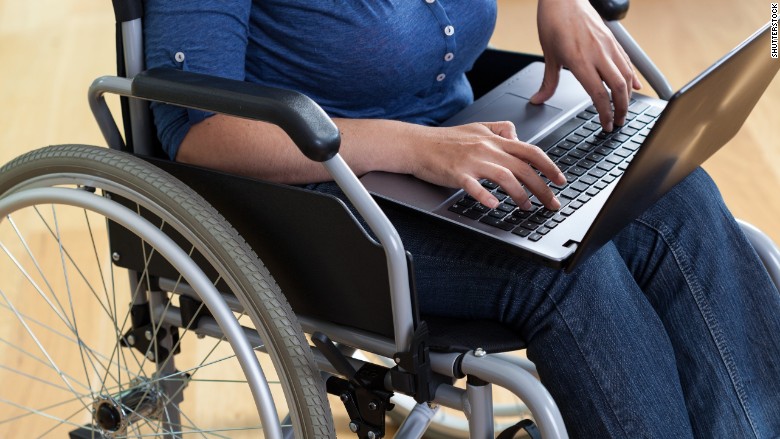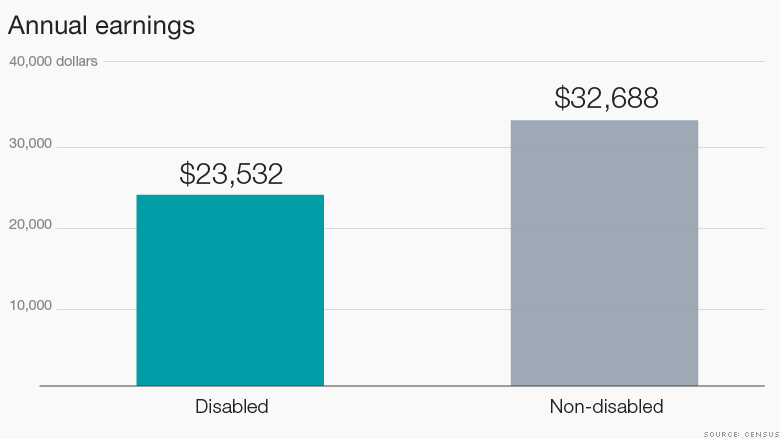
Jordan Gallacher hasn't had a job in three years. Many employers reject him with a form letter or email, but one said outright: "We don't hire blind people."
Gallacher, 28, is a computer expert. He has a bachelor's degree in management and entrepreneurship from Louisiana Tech University. Yet most employers don't give him a second glance when they learn he's blind, even though he is able to operate a computer just fine with a screen reader.
Gallacher is one of nearly 57 million disabled people in America.
Today marks the 25th anniversary of the Americans with Disability Act (ADA), a civil rights act passed in 1990 to fight discrimination against the disabled.
Related: When school's out, millions of kids go hungry
Since its inception, much has changed for the better. Supermarket aisles are wider, schools have ramps, and public transportation is more accessible for the disabled.
But there's one thing that's deteriorated for them -- employment.
Show me the jobs: Employment for disabled Americans has actually fallen since 1990, and there's an even bigger gap between disabled and non-disabled jobs prospects today.

In the early 1990s, about half of disabled Americans were employed, according to Census data. Today that has fallen to just 41%. Some of the decline is due to an aging population. Older workers are more likely to have disabilities, especially physical ones.
But it's telling that the employment rate of disabled Americans has dropped more than for the non-disabled.
The problems often start at an early age.
Related: Dunkin' CEO: $15 minimum wage is 'outrageous'
Basic barriers remain: While in high school, Gallacher had three teachers who he says didn't accommodate for his disability in their classes. He found similar problems when he entered college, which is why he transferred to Louisiana Tech from a different university that did not cater to his needs at all.
"As a mother of student with disability, I've seen how many schools don't have ramps that are usable. I am just stunned that there hasn't been more attention in our education system to these very obvious emblems of discrimination," said Susan Dooha, executive director of the Center for Independence of the Disabled, who herself suffers from a traumatic brain injury.
Being fully blind in the small town of Pearl River in Louisiana does not open up a lot of options for Gallacher. He says he might be the only disabled person in his town so people don't know how to deal with him.
Related: Starbucks, other companies to hire 100K young people
The only jobs he's had are volunteering stints. He still lives with his parents and is grateful they support him financially.
"I'm always amazed at how many job applications I try to fill it out online but can't get any further because the rest of the offline application becomes inaccessible," said Gallacher. Many businesses no longer list Human Resources contact info, so he can't even call to seek help.

Low wage jobs: Even for those with jobs, the prospects remain bleak. Disabled persons earn significantly less than non-disabled, and the gap between annual earnings has widened since the early 1990s.
Disabled workers earn about $9,000 less a year than a non-disabled workers, according to Census data on median earnings. That gap was under $6,000 in the early 1990s.
A report by the Center for Independence of the Disabled found that the top job for non-disabled people is teaching. For the disabled, it's janitorial duties.
It often takes individual companies changing their policies to really make a difference. Some large companies like Citigroup (C) and Google (GOOG) are going the extra mile to include the disabled.
Related: Russia's slump pushes 3 million into poverty
Positive change: "I think the best thing I've seen [since the ADA] is corporations beginning to pay attention to disability as element of diversity," said Dooha. "Reversing the thinking that they are a burden and instead thinking about them as having strength to bring to the workforce."
For instance, Citi provide trainings specifically referring to consideration for persons with disabilities. Globally, Citi has five Persons with Disability Networks.
For the last four years, Citi has hosted the NYC Disability Mentoring Day (DMD) in New York city. The event promotes career development for students and job-seekers with disabilities through hands-on career exploration and ongoing mentoring relationships.
Dooha also commends tech innovations to remove barriers to participation for the disabled.
Related: Kids of working moms are better off
Companies stepping up: A healthy five-year-old boy in Charleston, South Carolina, came down with Meningococcal meningitis and his life changed.
Charles Rogers had his hands and legs below the knee amputated following the horrible disease. But Charles has graduated college and worked at Walmart (WMT) in Murfreesboro, Tennessee for 12 years.
He recently drove to Atlanta and stayed at a hotel for six weeks for training after being promoted to assistant manager.
"Before I started working with Walmart, I got interviews but once the interview was over, there was no response," said Rogers. "Walmart actually gave me a chance."
Walmart is one of the leading employers of the disabled, and they offer training and resource groups for them.
The more employers encourage the disabled, the better. Customers in wheelchairs often approach Rogers in the store and ask him about his job and if the store is hiring.
"Being out there and working in the store is the best thing I can do to show other disabled people that they can do it too," Rogers said.


